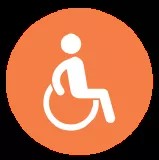Blackboard's Inclusive Thinking Framework is based on the theories of Universal Design for Learning. It provides a strategy for building educational experiences that are intentionally designed to meet the needs of students with diverse needs first. This results in more engaging learning experiences for all.
The National Center for Educational Restructuring and Inclusion (NCERI), defines inclusivity as the following.
Providing to all students, including those with significant disabilities, equitable opportunities to receive effectual educational services, with the needed supplementary aids and support services, in age appropriate classrooms in their neighborhood schools, in order to prepare students for productive lives as full members of society.
What is an inclusive classroom?
Many classrooms today, both physical and digital, are integrated. Students with diverse needs are included in general education methods, they are physically in the same place, but they are expected to complete exactly the same work in exactly the same manner.
Building an inclusive classroom doesn't mean getting all students in the same space, doing the same things, in the same ways. It means enabling everyone in the classroom to achieve the same goals, even if the method of doing so is different. Inclusive classrooms put the focus on the learning objective instead of the activity to measure it. They require all students to meet the same learning objectives using assessments that are built to target the needs of the individual student.
Example: In an integrated writing classroom all students are asked to find a photo that means something to them and tell the class about it. Someone with a visual disability can ask someone to pick a photo for them and tell them about it. With this knowledge, they can complete the activity. In an inclusive writing classroom this assignment asks students to find anything that means something to them and tell the class about it. The student can do more than complete the activity, they can achieve the objective: share something meaningful with the class.
As with Universal Design for Learning, inclusive classrooms benefit all students. But learners with diverse needs are more engaged and more social in inclusive classrooms. They, along with their typically developing peers, benefit more from collaborative learning and positive environments where everyone has an equal opportunity to be successful.
Understanding diverse needs
Building inclusive classrooms starts with understanding the diverse needs your students may have.
Someone with a visual disability...
- May struggle to see certain colors.
- May have low vision and rely on assistive devices to help them see (glasses, magnifiers, etc.)
- May be completely blind and rely on screen readers to consume digital content.
Someone with a hearing disability...
- May have limited hearing and rely on assistive devices to help them (hearing aids, implants, etc.)
- May be completely deaf and rely on sign language or text based alternatives to audio content.
Someone with a physical disability...
- May not have control over gross or fine muscles required to use technology.
- May rely on alternative input devices to interact with digital content.
Someone with a cognitive disability...
- May have difficulty receiving and processing information.
- May be easily distracted and have trouble with memory.
- May rely on assistive tools for reading and comprehension assistance.
Building inclusive classrooms
Many teachers feel they lack the knowledge, awareness, or time to build inclusive experiences into their classroom. We've created this framework to give you the foundations for building inclusive classrooms.
There are three key things you need to consider to build a truly inclusive classroom.
- The pedagogy you've developed.
- The content you're building or providing.
- The tools and technology you're using in the classroom.
Step One: Inclusive Pedagogy
Thinking inclusively about your pedagogy means potentially rethinking how learning is achieved and providing the means to help students succeed. Review your curriculum looking for ways to ensure these best practices throughout your course.
- A syllabus has been made available within the course and is easily accessible for all students.
- The course goals and learning outcomes are clearly defined, either in your syllabus or in the course units themselves.
- You've taken the time to develop differentiated activities when applicable. Giving your students options for how best to showcase their knowledge and understanding increases engagement and ensures all learning styles and needs can be met without complex accommodations.
- You've created opportunities for collaborative learning throughout the class.
- Explicit instruction is provided for all units, assessments, and activities. It's important that people understand exactly what's expected of them.
- You've been using the principles of Universal Design for Learning throughout your curriculum.
Step Two: Inclusive Content
Thinking inclusively means revisiting content and ensuring it's set up for universal consumption. It also means choosing not to use content that doesn't meet expectations. Evaluate all of the content in your course for the following elements.
- All Images have alternative text or have been explicitly marked as decorative.
- You are not using images of text in your content.
- You do not have any blinking images or animations in your course. If you do, the animations are critical to the material and not just fun and interesting. If you keep them make sure that you've properly explained what the animation is conveying in alternative text or detailed text descriptions.
- All Word and PowerPoint documents are properly structured.
- All PDFs are tagged for accessibility.
- All Videos are captioned.
- All of the colors you are using have proper contrast between the background and foreground
- Tables are not used for layout anywhere in the content.
Step Three: Inclusive Technology and Tools
Thinking inclusively means understanding how people need to interact with different tools you are using and adjusting or accommodating as necessary. When selecting tools and technology to use in your classroom consider how it may impact people with diverse needs.
- Do colors within the application have proper contrast?
- Does the entire page magnify, not just the text?
- Are all controls are accessible with a keyboard?
- Does clicking form labels move the cursor to the right element?
- Are audio and visual notifications provided in more than one format?
- Is the content is clear when style sheets are disabled in the browser?
- Are there additional plug-ins and downloads required?
Inclusive Classroom Summary
Building inclusive classrooms seems like a lot of extra work. The value is not in the completion but in the thinking. Remember there is no one size fits all solution. Thinking inclusively is about setting up all your students for success.
- Start off the right way with your next course. It's easier to build things inclusively from the beginning rather than trying to fix them later on.
- Pair up, find a colleague with similar goals, teaching a similar class. Share resources and ideas and work together for some small wins.
- There is no wrong answer. You can choose to use anything you want, just have a plan and know how you'll adjust on the fly if something does not work.
Want more? Watch a recording of the Building Inclusive Classrooms Webinar (available in English only). You can also download the Inclusive Classroom Checklists (available in English only).




